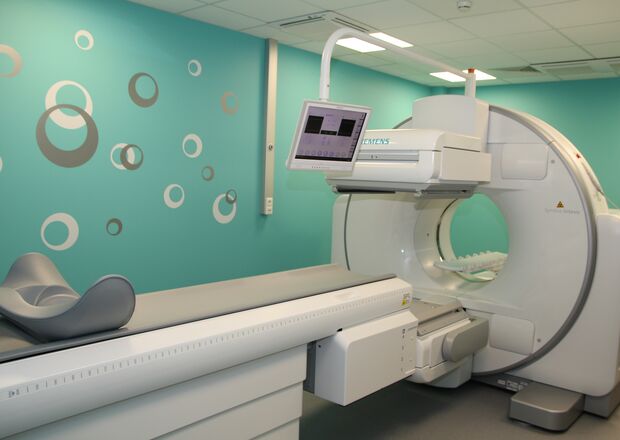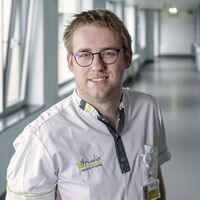Nuclear medicine
Plan your appointment
What can we help you with?
Scintigraphies (scans) are made at the nuclear medicine department. The team will guide you during the examination and inform you about all aspects of the examination. If you have any further questions, you may always ask them.
In these tests, a small amount of a radioactive substance (isotope) is administered. Through a special molecule, the isotope will concentrate in the organ to be examined. The administered radioactivity is measured by means of a gamma camera and converted into images, so the camera itself does not emit any radiation.
This allows the doctor to evaluate the shape and function of that organ. Many organs can be examined this way: the bone system, heart, lungs, kidneys, brain, thyroid gland, etc.
Examinations/treatments
At the nuclear medicine department, you can go for the following examinations or treatments:
- Bone marrow scintigraphy (Nanocolloid scan)
- Thyroid scintigraphy
- Bone scintigraphy of the whole body
- Bone scintigraphy 3-phase study
- Cisternography
- DAT scan
- Detecting gastrointestinal hemorrhage
- Brain perfusion scintigraphy with TC-ECD
- Lung ventilation perfusion scintigraphy
- Lymphatic scintigraphy
- Maage evacuation study
- Meckel scintigraphy
- Myocardial scintigraphy (thallium scintigraphy)
- Kidney scintigraphy dynamic (MAG3 or DTPA)
- Kidney scintigraphy static (DMSA scintigraphy)
- Thyroid scintigraphy
- Sentinel scintigraphy
- Salivary gland scintigraphy
- Therapy with radioactive iodine (I-131) (pdf)
- Therapy with Strontium-89 (pdf)
- Therapy with Xofigo
- Vascular scan (HSA)
- Ventriculography
Frequently Asked Questions

SPECT-CT device
For a nuclear examination, we use a SPECT-CT device. This is a hybrid device that combines nuclear examination and a CT scan.
In the first examination, we can see how a slightly radioactive substance moves through the body and organs and where the disease process is located. In the second, we map the anatomical location. A combination of the two allows for a better diagnosis, is much more pleasant and time- and cost-saving for the patient. The nuclear medicine department works closely with fellow doctors at radiology for this purpose.
In the past, patients sometimes had to have two separate examinations for a correct diagnosis. Now, for some problems (e.g. certain types of low back pain), with just one examination we can not only tell what is going on but also indicate more precisely where the problem is located.
Information brochures
Where can you find us?
Before going to this department for your examination, you should always enroll at the registration kiosk in the entrance hall. Here you will receive further instructions.

